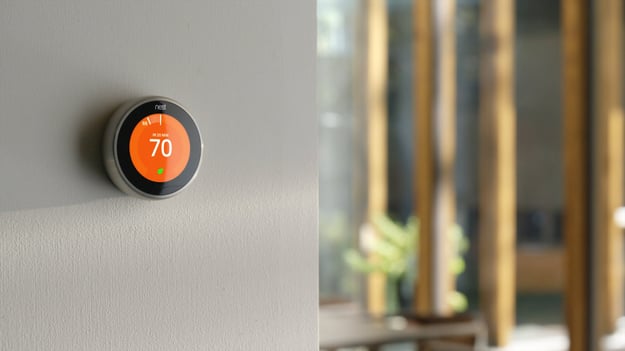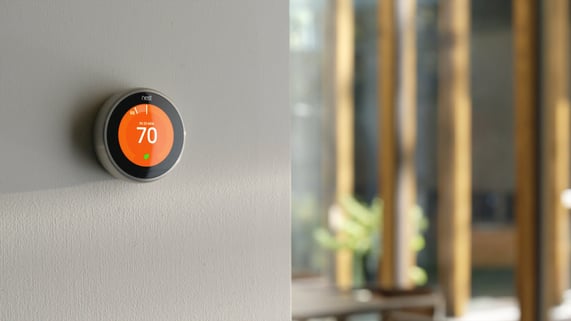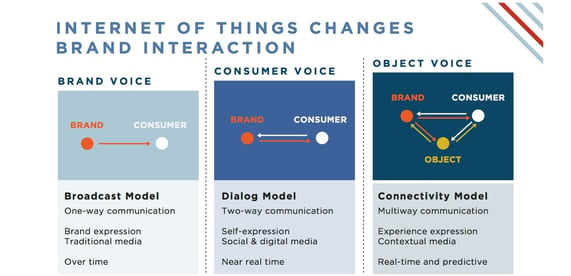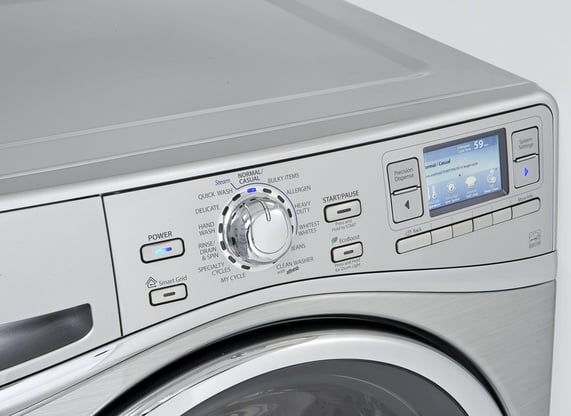Foresights and ideas that expand minds and inspire a change of heart.

Internet of Things (IoT) is a topic which we often write and research about at Thinque. The reason why we are so intrigued by this phenomenon is because it's impacting so many different aspects of the business landscape and our society as a whole.

The Nest Learning Thermostat.
In a previous blog post, we wrote about the way connected devices will impact retail and we have also written about IoT's potential to enable smarter cities. However, in this blog post, we will take a closer look at how IoT or machine-to-machine communications as it's also referred to reshapes the customer journey and changes the way consumers interact with brands.
Physical products like smart home devices are becoming more like nodes in an ecosystem of connected services.
Physical products like smart home devices are becoming more like nodes in an ecosystem of connected services. One example is Nest which could be defined as a central intelligence hub for your home. The Nest can learn your schedule, then program itself and be controlled from your smartphone which enables you to reduce your energy footprint, lower your heating and cooling bills. 
The visualisation above is inspired by Altimeter's model
As we've mentioned above, the Internet of Things is changing the way brands interact with consumers. The broadcast model, one-to-many communication, were popular before the corporations had access to digital technology. But as Internet became adopted by an increasing number of consumers and brands, this model began to change. Social and digital media enabled brands and consumers to have real dialogues with customers instead of just one-way communication, and as a result, individual consumers were given the opportunity to interact with brands in a whole new way. Brands, on the other hand, got the chance to collect data and insights from their customers by monitoring social media.
Whirpool's connected dryer/washer.
The Internet of Things has transformed the dialog between consumers and brands and enabled any element of the brand experience to have a voice. The consumer can now communicate directly with the object which in turn can communicate with the brand. This dialog could be both real-time and predictive.
The Internet of Things has transformed the dialog between consumers and brands and enabled any element of the brand experience to have a voice.
Smart devices can gather insights from its user/users to address and resolve problems in real-time. One interesting example of such a device is Whirpool's latest connected washer/dryer which has its own diagnostic tool. So when an error occurs, the machine itself can diagnose and find out what the problem is and then provide simple how-to guides to help the user to resolve the problem in real-time.
Smart brands such as Nest, Whirpool and Amazon have realised that these IoT-solutions can be used as a means to create immersive customer experiences where the transitions between the physical and the digital channels are truly seamless. In conclusion, tomorrow's successful brands will be those who invest in customer relationships over time and are dedicated to both remove any potential friction points and transform the lives of their customers.

Header Text
Lorem ipsum dolor sit amet, consectetur adipiscing elit, sed do eiusmod tempor incididunt ut labore et dolore magna aliqua. Ut enim ad minim veniam, quis nostrud exercitation ullamco laboris nisi ut aliquip ex ea commodo consequat. Duis aute irure dolor in reprehenderit in voluptate velit esse cillum dolore eu fugiat nulla pariatur.
Lorem ipsum dolor sit amet, consectetur adipiscing elit, sed do eiusmod tempor incididunt ut labore et dolore magna aliqua. Ut enim ad minim veniam, quis nostrud exercitation ullamco laboris nisi ut aliquip ex ea commodo consequat. Duis aute irure dolor in reprehenderit in voluptate velit esse cillum dolore eu fugiat nulla pariatur.
Lorem ipsum dolor sit amet, consectetur adipiscing elit, sed do eiusmod tempor incididunt ut labore et dolore magna aliqua. Ut enim ad minim veniam, quis nostrud exercitation ullamco laboris nisi ut aliquip ex ea commodo consequat. Duis aute irure dolor in reprehenderit in voluptate velit esse cillum dolore eu fugiat nulla pariatur.

Header Text
Lorem ipsum dolor sit amet, consectetur adipiscing elit, sed do eiusmod tempor incididunt ut labore et dolore magna aliqua. Ut enim ad minim veniam, quis nostrud exercitation ullamco laboris nisi ut aliquip ex ea commodo consequat. Duis aute irure dolor in reprehenderit in voluptate velit esse cillum dolore eu fugiat nulla pariatur.
Lorem ipsum dolor sit amet, consectetur adipiscing elit, sed do eiusmod tempor incididunt ut labore et dolore magna aliqua. Ut enim ad minim veniam, quis nostrud exercitation ullamco laboris nisi ut aliquip ex ea commodo consequat. Duis aute irure dolor in reprehenderit in voluptate velit esse cillum dolore eu fugiat nulla pariatur.
Lorem ipsum dolor sit amet, consectetur adipiscing elit, sed do eiusmod tempor incididunt ut labore et dolore magna aliqua. Ut enim ad minim veniam, quis nostrud exercitation ullamco laboris nisi ut aliquip ex ea commodo consequat. Duis aute irure dolor in reprehenderit in voluptate velit esse cillum dolore eu fugiat nulla pariatur.

Header Text
Lorem ipsum dolor sit amet, consectetur adipiscing elit, sed do eiusmod tempor incididunt ut labore et dolore magna aliqua. Ut enim ad minim veniam, quis nostrud exercitation ullamco laboris nisi ut aliquip ex ea commodo consequat. Duis aute irure dolor in reprehenderit in voluptate velit esse cillum dolore eu fugiat nulla pariatur.
Lorem ipsum dolor sit amet, consectetur adipiscing elit, sed do eiusmod tempor incididunt ut labore et dolore magna aliqua. Ut enim ad minim veniam, quis nostrud exercitation ullamco laboris nisi ut aliquip ex ea commodo consequat. Duis aute irure dolor in reprehenderit in voluptate velit esse cillum dolore eu fugiat nulla pariatur.
Lorem ipsum dolor sit amet, consectetur adipiscing elit, sed do eiusmod tempor incididunt ut labore et dolore magna aliqua. Ut enim ad minim veniam, quis nostrud exercitation ullamco laboris nisi ut aliquip ex ea commodo consequat. Duis aute irure dolor in reprehenderit in voluptate velit esse cillum dolore eu fugiat nulla pariatur.
& STAY UP TO DATE WITH FORESIGHTS AND TREND REPORTS!
WE WILL EQUIP YOU WITH THE VIDEOS AND MATERIALS YOU NEED TO SUCCESSFULLY PITCH ASN.
0 Comment